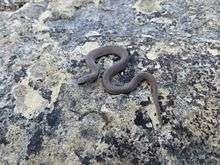Virginia valeriae
| Virginia valeriae | |
|---|---|
 | |
| A Smooth Earth Snake from Madison County, Iowa | |
| Scientific classification | |
| Kingdom: | Animalia |
| Phylum: | Chordata |
| Subphylum: | Vertebrata |
| Class: | Reptilia |
| Order: | Squamata |
| Suborder: | Serpentes |
| Family: | Colubridae |
| Subfamily: | Natricinae |
| Genus: | Virginia |
| Species: | V. valeriae |
| Binomial name | |
| Virginia valeriae Baird & Girard, 1853 | |
| Synonyms | |
| |
Virginia valeriae, commonly known as the smooth earth snake, is a species of nonvenomous natricine colubrid snake native to the eastern half of the United States.
Etymology
The specific name or epithet, valeriae, is in honor of Valeria Biddle Blaney, who collected the first specimen in Kent County, Maryland, and was a first cousin of Spencer Fullerton Baird.[3]
Geographic range
It is found from Texas and Iowa to New Jersey and Florida.
Description
Rostral nearly as deep as broad, visible from above; internasals much shorter than the prefrontals; frontal longer than broad, shorter than the parietals; loreal one and a half to two and a half times as long as deep; two or three postoculars; temporals 1+2; six upper labials, third and fourth entering the eye; four lower labials in contact with the anterior chin shields, which are as long as or shorter than the posterior. Dorsal scales in 15 or 17 rows. Anal divided. Ventrals 111-135; subcaudals 24-37.[4]
The following description of coloration of a live specimen (not in alcohol) uses Robert Ridgway's Color Standards and Color Nomenclature (1912). Dorsally Virginia valeriae is benzo brown, deep brownish drab, mars brown, or light brownish drab. The first row of dorsal scales is colored like the adjacent ventrals, which are light vinaceous-fawn, pale vinaceous-fawn, pale grayish vinaceous, or pale vinaceous-pink. The top of the head is hair brown or like the dorsum, with many dark spots on the plates. The upper labials are ecru-drab or lighter, some with drab-gray spots. There is a small black ring around the eye. The ventral surface of the head is white.[5]
Sometimes a faint median light line is present. Also, there may be tiny black spots on the back and sides, especially in the nominate race (Virginia valeriae valeriae).[6]
Adults are usually 18–25 cm (7.1–9.8 in) in total length; record 33.7 cm (13 1⁄4 in).[2]
Habitat
It is a small, fossorial species which spends most of its time buried in loose soil or leaf litter.
Diet
The smooth earth snake eats primarily earthworms and other soft-bodied arthropods.
Behavior
Given their lack of sufficient defense mechanisms against larger animals, earth snakes are generally not aggressive towards humans and are harmless if encountered. While they do have teeth, the size of the mouth and teeth make any strikes against humans superficial at worst. They can defecate as a defense mechanism to make them less palatable to would-be predators. If necessary, they can be safely picked up by hand and relocated.
Subspecies
Some sources list two subspecies of Virginia valeriae:
- Virginia valeriae elegans Kennicott, 1859 - western earth snake, dorsal scales in 17 rows, southern Indiana through western Kentucky and Tennessee to the Gulf of Mexico, westward to eastern Kansas and central Texas.
- Virginia valeriae valeriae (Baird & Girard, 1853) - eastern earth snake, dorsal scales in 15 rows, New Jersey to Georgia and west through northern Alabama, Tennessee, and southern Ohio.[7]
Reproduction
This species bears live young in August. Brood size is usually fewer than 10. The total length of a newborn is about 6 cm (about 2.5 in).[5]
References
- ↑ The Reptile Database. www.reptile-database.org.
- 1 2 Conant, R. 1975. A Field Guide to Reptiles and Amphibians of Eastern and Central North America, Second Edition. Houghton Mifflin. Boston. xvii + 429 pp. ISBN 0-395-19979-4 (hardcover), ISBN 0-395-19977-8 (paperback). (Virginia valeriae, pp. 167-168 + Plate 22 + Map 125.)
- ↑ Beltz, Ellin. 2006. Scientific and Common Names of the Reptiles and Amphibians of North America - Explained.
- ↑ Boulenger, G.A. 1894. Catalogue of the Snakes in the British Museum (Natural History), Volume II., Containing the Conclusion of the Colubridæ Aglyphæ. Trustees of the British Museum (Natural HIstory). (Taylor and Francis, Printers.) London. xi + 382 pp. + Plates I.- XX. (Virginia valeriæ, p. 289.)
- 1 2 Wright, A.H., and A.A. Wright. 1957. Handbook of Snakes of the United States and Canada. Comstock. Ithaca and London. 1,105 pp. (in 2 volumes) (Haldea valeriae, pp. 290-293, Figure 89. + Map 27. on p. 288.)
- ↑ Smith, H.M., and E.D. Brodie, Jr. 1982. Reptiles of North America: A Guide to Field Identification. Golden Press. New York. 240 pp. ISBN 0-307-13666-3 (paperback). (Virginia valeriae, pp. 152-153.)
- ↑ Schmidt, K.P., and D.D. Davis. 1941. Field Book of Snakes of the United States and Canada. G.P. Putnam's Sons. New York. 365 pp. (Haldea valeriae, pp. 232-234, Figure 76.)
Further reading
- Baird, S.F., and C.F. Girard 1853. Catalogue of North American Reptiles in the Museum of the Smithsonian Institution. Part I.—Serpents. Smithsonian Institution. Washington, District of Columbia. xvi + 172 pp. (Virginia valeriæ, p. 127.)
- Conant, R., and W. Bridges. 1939. What Snake Is That? A Field Guide to the Snakes of the United States East of the Rocky Mountains. D. Appleton-Century. New York and London. Frontispiece map + viii + 163 pp. + Plates A-C, 1-32. (Virginia valeriae, pp. 112–113 + Plate 21, Figure 62.)
- Morris, P.A. 1948. Boy's Book of Snakes: How to Recognize and Understand Them. A volume of the Humanizing Science Series, edited by Jacques Cattell. Ronald Press. New York. viii + 185 pp. ("The Ground Snake", pp. 73–74, 180.)
External links
- Species Virginia valeriae at The Reptile Database